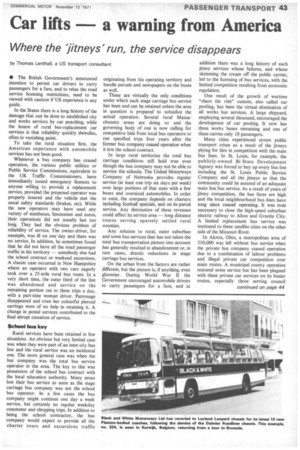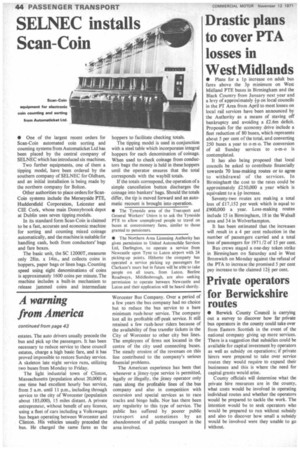Car lifts a warning from America
Page 45

Page 46

If you've noticed an error in this article please click here to report it so we can fix it.
Where the jitneys' run, the service disappears
by Thomas Lenthall, a US transport consultant • The British Government's announced intention to permit car drivers to carry passengers for a fare, and to relax the road service licensing restrictions, need to be viewed with caution if US experience is any guide.
In the States there is a long history of the damage that can be done to established city and works services by car poaching, while the lesson of rural bus-replacement car services is that reliability quickly dwindles, often to vanishing point.
To take the rural situation first, the American experience with automobile services has not been good.
Whenever a bus company has ceased operation. the various public utilities or Public Service Commissions, equivalent to the UK Traffic Commissioners, have immediately issued emergency licences to anyone willing to provide a replacement service, provided the proposed operator was properly insured and the vehicle met the usual safety standards (brakes, etc). While the new operators may have used any variety of minibuses, limousines and autos, their operations did not usually last too long. They had the obvious problem of reliability of service. The owner-driver, for example, was ill on one day and there was no service. In addition, he sometimes found that he did not have all the road passenger traffic in his territory — somebody else had the school contract or weekend excursions. A classic case occurred in New Hampshire where an operator with two cars eagerly took over a 25-mile rural bus route. In a very short time, the outer third of the line was abandoned and service on the remaining portion cut to three trips a day. with a part-time woman driver. Patronage disappeared and even her colourful pierced earrings were of no help in retaining it. A change in postal services contributed to the final abrupt cessation of service.
School bus key
Rural services have been retained in few situations. An obvious but very limited case was when they were part of an inter-city bus line and the rural service was an incidental one. The more general case was when the bus company was the total bus service operator in the area. The key to this was possession of the school bus contract with the local education authority. Many areas lost their bus service as soon as the stage carriage bus company was not the school bus operator. In a few cases the bus company might continue one day a week service, but certainly no regular weekday commuter and shopping trips. In addition to being the school contractor, the bus company would expect to provide all the charter tours and excursions traffic originating from his operating territory and handle parcels and newspapers on the buses as well.
These are virtually the only conditions under which such stage carriage bus service has been and can be retained unless the area in question is prepared to subsidize the actual operation. Several rural Massachusetts areas are doing so and the governing body of one is now calling for competitive bids from local bus operators to run specified trips four years after the former bus company ceased operation when it lost the school contract.
In large rural territories the total bus carriage conditions still hold true even though the bus company may not be able to service the schools. The United Motorways Company of Nebraska provides regular service (at least one trip six days per week) over large portions of that state with a few buses and oversized automobiles. In order to exist, the company depends on charters including football specials, and on its parcel service. Any diminution of these revenues could affect its service area — long distance routes serving sparsely settled rural counties.
Any solution to rural, outer suburban and town bus services that has not taken the total bus transportation picture into account has generally resulted in abandonment or, in rare cases, drastic reductions in stage carriage bus services.
On the urban front the factors are rather different, but the picture is, if anything, even gloomier. During World War II the Government encouraged automobile drivers to carry passengers for a fare, and in addition there was a long history of such jitney services whose failures, and whose skimming the cream off the public carrier, led to the licensing of bus services, with the limited competition resulting from economic regulation.
One result of the growth of wartime "share the ride" custom, also called car pooling, has been the virtual elimination of all works bus services. A large shipyard, employing several thousand, encouraged the development of car pooling. It now has three works buses remaining and one of these carries only 18 passengers.
Many cities experienced severe public transport crises as a result of the jitneys plying for hire in competition with the main bus lines. In St. Louis, for example, the publicly-owned Bi-State Development Agency was forced to buy up every bus line including the St. Louis Public Service Company and all the jitneys so that the community could be assured of an adequate main line bus service. As a result of years of jitney competition, the bus fares are high and the local neighbourhood bus lines have long since ceased operating. It was even necessary to close the high-speed suburban electric railway to Alton and Granite City. A limited replacement bus service was instituted to these satellite cities on the other side of the Missouri River.
In Akron, Ohio, a metropolitan area of 350,000 was left without bus service when the private bus company ceased operation due to a combination of labour problems and illegal private car competition over main routes. A municipal county operation restored some service but has been plagued with these private car services on its busier routes, especially those serving council
estates. The auto drivers usually precede the bus and pick up the passengers. It has been necessary to reduce service to these council estates, charge a high basic fare, and it has proved impossible to restore Sunday service. A skeleton late night service runs, utilizing two buses from Monday to Friday.
The light industrial town of Clinton, Massachusetts (population about 20,000) at one time had excellent hourly bus service, from 5 a.m. until 11 p.m., including through service to the city of Worcester (population about 185,000), 15 miles distant. A private entrepreneur, without benefit of any licence, using a fleet of cars including a Volkswagen bus began operating between Worcester and Clinton. His vehicles usually preceded the bus. He charged the same fares as the Worcester Bus Company. Over a period of a few years the bus company had no choice but to reduce the bus service to a bare minimum rush-hour service. The company lost all its profitable off-peak service. It still retained a few rush-hour riders because of the availability of free transfer tickets in the City of Worcester to other city bus lines. The employees of firms not located in the centre of the city used connecting buses. The steady erosion of the revenues on this line contributed to the company's serious financial problems.
The American experience has been that whenever a jitney-type service is permitted, legally or illegally, the jitney operator only runs along the profitable lines of the bus company and also in competition with excursion and special services as to race tracks and bingo halls. Nor has there been any regularity to this type of service. The public has suffered by poorer public transport and sometimes by an abandonment of all public transport in the area involved.










































































































































































































